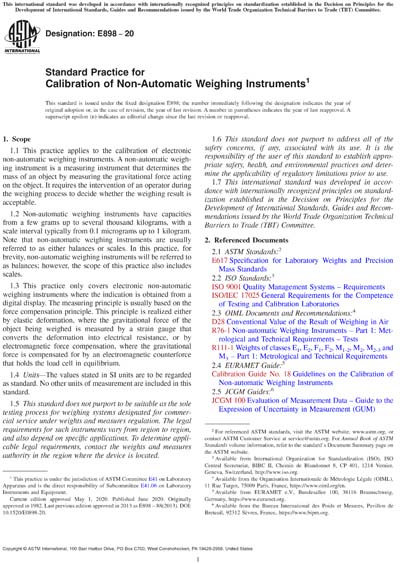Most recent
ASTM E898-20
Standard Practice for Calibration of Non-Automatic Weighing Instruments
1.1 This practice applies to the calibration of electronic non-automatic weighing instruments. A non-automatic weighing instrument is a measuring instrument that determines the mass of an object by measuring the gravitational force acting on the object. It requires the intervention of an operator during the weighing process to decide whether the weighing result is acceptable.
1.2 Non-automatic weighing instruments have capacities from a few grams up to several thousand kilograms, with a scale interval typically from 0.1 micrograms up to 1 kilogram. Note that non-automatic weighing instruments are usually referred to as either balances or scales. In this practice, for brevity, non-automatic weighing instruments will be referred to as balances; however, the scope of this practice also includes scales.
1.3 This practice only covers electronic non-automatic weighing instruments where the indication is obtained from a digital display. The measuring principle is usually based on the force compensation principle. This principle is realized either by elastic deformation, where the gravitational force of the object being weighed is measured by a strain gauge that converts the deformation into electrical resistance, or by electromagnetic force compensation, where the gravitational force is compensated for by an electromagnetic counterforce that holds the load cell in equilibrium.
1.4 Units—The values stated in SI units are to be regarded as standard. No other units of measurement are included in this standard.
1.5 This standard does not purport to be suitable as the sole testing process for weighing systems designated for commercial service under weights and measures regulation. The legal requirements for such instruments vary from region to region, and also depend on specific applications. To determine applicable legal requirements, contact the weights and measures authority in the region where the device is located.
1.6 This standard does not purport to address all of the safety concerns, if any, associated with its use. It is the responsibility of the user of this standard to establish appropriate safety, health, and environmental practices and determine the applicability of regulatory limitations prior to use.
1.7 This international standard was developed in accordance with internationally recognized principles on standardization established in the Decision on Principles for the Development of International Standards, Guides and Recommendations issued by the World Trade Organization Technical Barriers to Trade (TBT) Committee.
Content Provider
ASTM International [astm]






